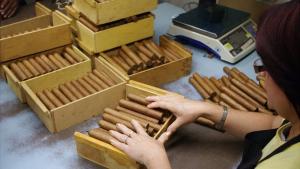More than just a regular cigarette, cigars have become a cultural symbol of Cuba, with a completely hand-made production process.

Cohiba cigarettes produced for customers usually cost /small and /big.

Mr. Raul Valdes Villasusan extended his calloused hand after many years in the profession

In 2015, the embargo between the US and Cuba was lifted, once again bringing Cuban cigars to the world. The Cuban cigar production process can be compared to the wine culture of Napa valley and becomes a major attraction for visitors in the near future. Some farmers earn extra income by allowing international guests to stay on the farm, taking them on a tour of the beautiful countryside and introducing the place where famous cigars are made.

One of the most famous is that of the Montesino family, about an hour’s drive west of Havana. Tobacco plants are usually planted at the end of the year for about 3 months before harvest. Each tree gives about 30 leaves and the farmer has to pluck each one very carefully.

Cigar growing is started in the two hottest months of the year, June and July, and lasts 9 months. The first is the preparation of the soil for sowing. The western region of Cuba is the best place to grow cigars. Before sowing seeds, the soil must be plowed several times and it is compulsory to plow with buffalo to avoid compaction. Then the seeds are sown and covered with straw, when the seeds are germinated, they will be transplanted until they reach a certain height, then they will be cut off to focus on developing leaves.

Buses carry farmers in the vicinity to the farm to work. Pinar del Rio is the most famous tobacco barn in Cuba

Then the fresh leaves are taken to the drying room.

The leaves are hung up to dry on their own. This process is also known as “curing” and takes about 3 months.

Montesino is an organic farm, without the use of pesticides or chemicals. The farmer uses his hand to catch insects that are attached to the leaves.

Montesino has been passed down for 3 generations. Photo: Owner Marcelo Montesino (right), standing next to his son Eulogio (left) – who will take over the property later.

After the leaves are completely dry, they are brought in for rolling.

The technique of rolling a cigar requires meticulousness because it will directly affect the quality of the whole cigarette. A good cigar should have a soft and glossy exterior, with all the leaves wrapping in the same direction.

Some Montesino farms also prepare food for visitors to the production site.

Farmers hope to export more cigars to foreign countries in the near future but still maintain a peaceful and peaceful life as they are now.

Packages of finished cigars ready to be shipped around the world

